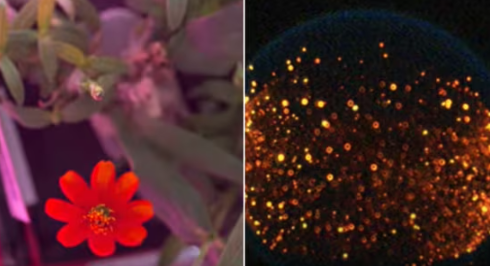The US space organization NASA frequently enlivens the internet with updates on the most recent discoveries about solar system planets, stars, and galaxies. It also offers eye-catching photos taken by its several spacecraft. The National Aeronautics and Space Administration (NASA) has just published the amazing results of science experiments conducted in orbit throughout the year 2023 on YouTube. The space agency released a video highlighting the experiments carried out on the International Space Station (ISS) this year, which included stunning gardens full of blossoming flowers and dancing flames.
The video was posted on Tuesday by NASA’s Lyndon B. Johnson Space Center Official YouTube Channel. Viewers can see experiments that are vital to the future of humankind’s space exploration efforts in this video. Explore the International Space Station with music, NASA wrote. Amazing science awaits you there.
You are taken on a fascinating, colorful, and enthralling tour of authentic space scientific experiments by astronaut Woody Hoburg. arranged to a classical soundtrack! Experiments on plant development! Learn about NASA’s space garden’s growth with the assistance of astronaut Christina Koch. “Avoid the spicy peppers!” the space agency added.
The science of fire is called combustion science. Explore how NASA investigates pulsating, dancing, and bouncing flames in orbit with astronaut Mark Vande Hei. Flowing demonstrations! NASA captioned the image, saying, “Astronaut Megan McArthur introduces you to the shapeshifting world of fluids and the fascinating ways they behave onboard the space station.”
The video was shared only a day ago, and now it has hundreds of likes and over 7,000 views. Some people in the comments section praised the video as outstanding, while others termed it wonderful.
Whoa, that’s very amazing, commented one user. NASA, you are amazing and we adore you. Salutations from Chile!” said another person.
A third user said, “That water is hypnotizing.” In any case, I find that some parts of fire resemble plasma. It’s also odd to believe that water may hold items similar to candies—I suppose it’s bubble-like in many ways. Still, great to see. The steam engine and more on Terra Forma are the results of certain water pressure movements that are being considered by the intellect. Seasonal greetings, a new user was added.
In particular, 2023 has been an extremely interesting year for space exploration. This year has seen the launch of numerous missions that have deepened our understanding of astronomy and expanded our reach into the cosmos. This year was significant, particularly for India, as the Indian Space Research Organisation (ISRO) accomplished the first-ever soft landing on the south pole of the moon.
The U.S. federal government’s autonomous National Aeronautics and Space Administration (NASA) is in charge of the country’s civil space program, aeronautics research, and space research. NASA was founded in 1958 to take over from the National Advisory Committee for Aeronautics (NACA) and give the American space development program a more civilian focus by emphasizing space science’s peaceful applications. Since then, NASA has been in charge of the majority of US space exploration initiatives, such as Project Mercury, Project Gemini, the Space Shuttle, the Skylab space station, the Apollo Moon landing missions, and 1968–1972. In addition to managing the construction of the Orion spacecraft and the Space Launch System for the crewed lunar Artemis program, the Commercial Crew spacecraft, and the envisioned Lunar Gateway space station, NASA presently assists the International Space Station.
NASA’s scientific endeavors are concentrated on enhancing comprehension of Earth via the Earth Observing System, propelling heliophysics via the endeavors of the Science Mission Directorate’s Heliophysics Research Programme, investigating bodies across the Solar System with cutting-edge robotic spacecraft like New Horizons and planetary rovers like Perseverance, and investigating astrophysics subjects like the Big Bang via the James Webb Space Telescope, the Great Observatories, and related initiatives. For its unmanned launches, NASA’s Launch Services Programme manages the countdown and oversees launch operations.
